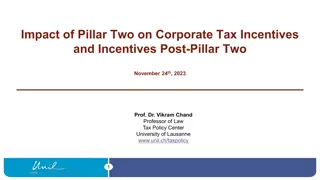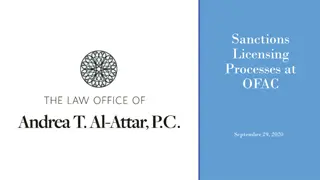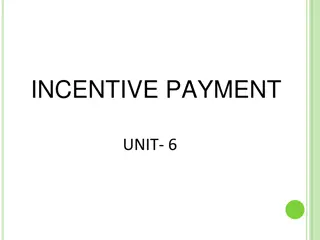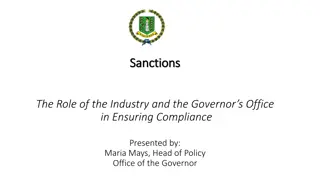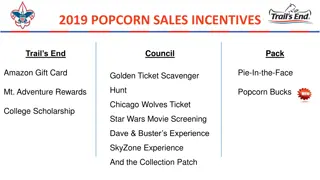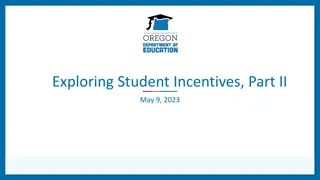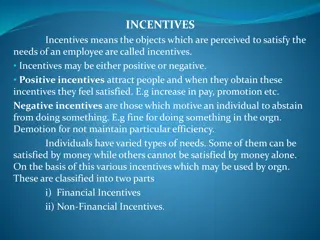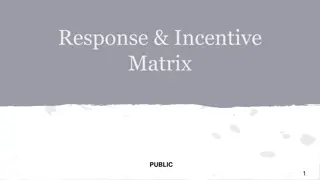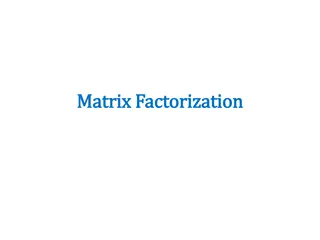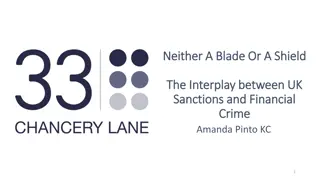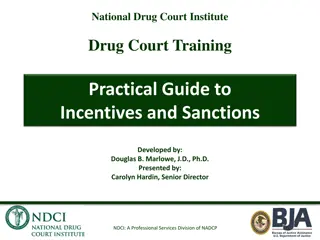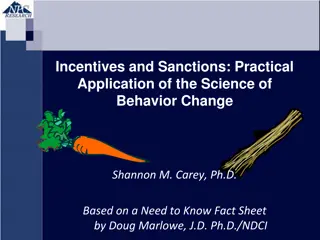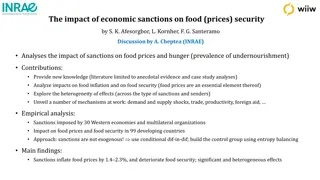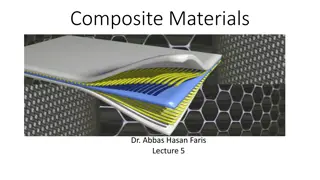Building and Using an Incentives and Sanctions Matrix for Behavior Modification
Learning to lead a drug-free lifestyle for the chronically addicted can be challenging, often involving repeated relapses and frustrations. This article explores the use of incentives and sanctions, emphasizing the importance of balancing positive reinforcement with punishment for behavior modification. It also highlights the significance of trust, verification, and the timing of supervision in promoting sustained prosocial behaviors among addicted individuals. Effective strategies discussed include certainty, immediacy, and procedural fairness in applying incentives and sanctions.
Download Presentation

Please find below an Image/Link to download the presentation.
The content on the website is provided AS IS for your information and personal use only. It may not be sold, licensed, or shared on other websites without obtaining consent from the author.If you encounter any issues during the download, it is possible that the publisher has removed the file from their server.
You are allowed to download the files provided on this website for personal or commercial use, subject to the condition that they are used lawfully. All files are the property of their respective owners.
The content on the website is provided AS IS for your information and personal use only. It may not be sold, licensed, or shared on other websites without obtaining consent from the author.
E N D
Presentation Transcript
BUILDING AND USING AN INCENTIVES AND SANCTIONS MATRIX
THE DAUNTING TASK Learning to lead a drug-free life style for the chronically addicted often involves repeated relapses and related frustrations before drug-free behavior becomes ingrained. Some enter Drug Court, at best, ambivalent towards recovery and, at worst, with little or no motivation to change. Promoting change, much less sustained prosocial, desirable behaviors amongst seriously addicted users, is a daunting task for even the most seasoned practitioner. Those who are motivated as well are equally challenging. SOURCE: CENTER FOR COURT INNOVATION
USING INCENTIVES AND SANCTIONS FOR BEHAVIOR MODIFICATION The Carrot and the Stick: Balance positive reinforcement with punishment to reduce undesired behaviors and replace them with desired prosocial behaviors. Incentives and Sanctions serve different, but complementary, functions. When used together, they can have synergistic effects that produce better outcomes than applying either technique alone (Marlow-2009) SOURCE: CENTER FOR COURT INNOVATION
USING INCENTIVES AND SANCTIONS FOR BEHAVIOR MODIFICATION TRUST BUT VERIFY! The most influential factor in modifying behavior is certainty.! Conduct urine testing on a truly random basis, including on weekends and holidays Community Supervision: Drug Courts that include LE/Community Corrections on their teams also tend to have better outcomes (Carey, 2008). Activities must include conducting random home contacts, verifying employment/school attendance, enforcing restrictions and monitoring compliance with probation requirements. SOURCE: NATIONAL DRUG COURT INSTITUTE
USING INCENTIVES AND SANCTIONS FOR BEHAVIOR MODIFICATION Timing is Everything! Go To: www.drugcourtonline.org Doug Marlow-Timing of Supervision SOURCE: BLENDED LEARNING TOOLKIT
TO BE MOST EFFECTIVE, INCENTIVES AND SANCTIONS NEED TO BE .. Certain: Avoid Surprises. Ensure that the participant is educated on the response (positive/negative) to the behavior. The matrix should be in the participant handbook Immediate: Respond immediately to each accomplishment/negative behavior so that the participant will associate the incentive or sanction with the behavior that is encouraged or discouraged Procedural Fairness SOURCE: CENTER FOR COURT INNOVATION
FURTHER CONSIDERATION Staying Centered: Magnitude Targeting Behaviors Don t expect too much Learned helplessness Don t expect too little Habituation SOURCE: CENTER FOR COURT INNOVATION
BEFORE YOU BEGIN.. The team should ask the following critical questions prior to establishing a matrix: What are the proximal and distal behaviors you are trying to shape? Have you prioritized your target behaviors by phase? Are the responses for addicts of a different magnitude than for abusers considering the proximal and distal target behavior goals? Have you used available local and national resources to expand your range of consequences? Does your list of responses reflect the importance of incentives? SOURCE: NATIONAL DRUG COURT INSTITUTE
THINGS TO CONSIDER: DELIVERING RESPONSES EFFECTIVELY Applying the 10 principles will enhance the probability of meaningful behavior change Responses are in the eyes of the behavior Sanctions should not be painful, humiliating or injurious Responses must be of sufficient intensity Responses should be delivered for every target behavior Undesirable behavior must be reliably detected Responses should be delivered immediately Responses must be predictable and controllable Responses may have unintentional side effects Behavior does not change by punishment alone The method of delivery of the response is as important as the response itself SOURCE: NATIONAL DRUG COURT INSTITUTE
BUILDING AND USING INCENTIVES AND SANCTIONS MATRIX Step 1- Begin by building a solid foundation of target behaviors. The team must consider what the target behaviors are in relation to proximal/distal behaviors. Are they realistic to accomplish? Can the person accomplish them? https://www.youtube.com/watch?feature=player_embedded&v=p3JPa2mvSQ4 The team should prioritize the behaviors they want to primarily shape in each phase of their program and design their incentive/sanction matrix to reflect these different priorities. SOURCE: NATIONAL DRUG COURT INSTITUTE
BUILDING AND USING INCENTIVES AND SANCTIONS MATRIX Step 2 Review the National Drug Court Institute list of incentives and sanctions Determine as a team your scope and access to resources to implement incentives and sanctions Request feedback from graduates on what motivated their behavior change and suggestions for incentives and sanctions that would be effective SOURCE: NATIONAL DRUG COURT INSTITUTE
BUILDING AND USING INCENTIVES AND SANCTIONS MATRIX Step 3 Utilizing the local and national resources, the team will need to develop a range of consequences for any given behavior Determine if the responses will be delineated by Phase SOURCE: NATIONAL DRUG COURT INSTITUTE
EXAMPLE OF AN INCENTIVE MATRIX RESPONSES TO BEHAVIOR ACHIEVEMENTS INCENTIVES Attending all court appearances Negative drug test results for period of time Attendance and participation in treatment Attendance and participation in support meetings Completion of GED College enrollment and attendance Job promotion Compliance with treatment/supervision plan Voluntary Speaking Engagements Artwork, Essays, Journals Phase Advancement Recognition and Praise by the Judge Courtroom recognition/STAR Board Certificates of achievement Buss Passes Movie/Event tickets or gift cards Reduction in Fines and Costs Decreased court appearances Phase advancement Voucher Assistance #1 on Docket of Choice Haircut/manicure/pedicure Food /Grab Box SOURCE: DENVER DRUG COURT
EXAMPLE OF A SANCTIONS MATRIX CHOICES SANCTIONS Missed court appearances Missed appointment with probation officer Missed support meetings Violation of court order Positive drug test Missed drug test (considered a positive drug test) Tampered drug test Missed treatment Inappropriate behavior at treatment facility New DUI or felony conviction Driving while license suspended/revoked Failure to perform sanctions Noncompliance with treatment plan Dishonesty Reprimand from the Judge Increased court appearances Increased drug testing Day Reporting to Probation, Court or facility Curfew Imposed Increase Probation Office Visits Work Release Additional community service hours Essay presented to Judge or gallery Attendance at Orientation, Graduation or docket Area/Association Restriction Placement on, GPS or SCRAM Saturday Work Program Sentence to Jail Increase contact in current phase SOURCE: DENVER DRUG COURT
RECAP Balance positive reinforcement with punishment Considerations of imposing incentives and sanctions Trust But Verify Timing Immediate Fairness Apply 10 principles that will enhance behavior change Understand Target Behavior! As a team, develop a realistic matrix SOURCE: CENTER FOR COURT INNOVATION


